Pentium 4 3.46 Extreme Edition and 925XE: 1066MHz FSB Support is Here
by Anand Lal Shimpi on October 31, 2004 3:00 PM EST- Posted in
- CPUs
Workstation Applications
Visual Studio 6
Carried over from our previous CPU reviews, we continue to use Visual Studio 6 for a quick compile test. We are still using the Quake 3 source code as our test and measure compile time in seconds. The results are pretty much in line with what we've seen in the past.
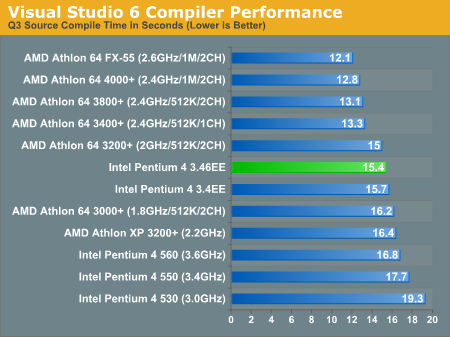
SPECviewperf 8
For our next set of professional application benchmarks we turn to SPECviewperf 8. SPECviewperf is a collection of application traces taken from some of the most popular professional applications, and compiled together in a single set of benchmarks used to estimate performance in the various applications the benchmark is used to model. With version 8, SPEC has significantly improved the quality of the benchmark, making it even more of a real world indicator of performance.
We have included SPEC's official description of each one of the 8 tests in the suite.
3dsmax Viewset (3dsmax-03)
"The 3dsmax-03 viewset was created from traces of the graphics workload generated by 3ds max 3.1. To insure a common comparison point, the OpenGL plug-in driver from Discreet was used during tracing.
The models for this viewset came from the SPECapc 3ds max 3.1 benchmark. Each model was measured with two different lighting models to reflect a range of potential 3ds max users. The high-complexity model uses five to seven positional lights as defined by the SPECapc benchmark and reflects how a high-end user would work with 3ds max. The medium-complexity lighting models uses two positional lights, a more common lighting environment.
The viewset is based on a trace of the running application and includes all the state changes found during normal 3ds max operation. Immediate-mode OpenGL calls are used to transfer data to the graphics subsystem."
The biggest surprise here is that there is a huge performance impact (13%) by moving down to a single channel memory subsystem with the Athlon 64. There are also a couple of other surprises, with the Pentium 4 560 doing surprisingly well, coming in at the heels of the Athlon 64 FX-55.
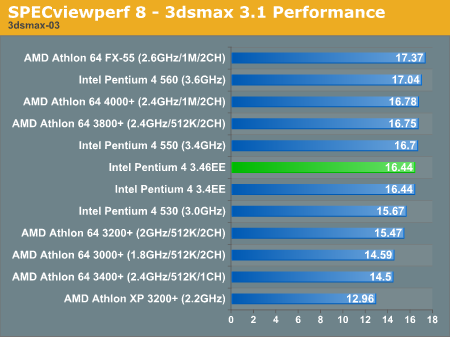
CATIA Viewset (catia-01)
"The catia-01 viewset was created from traces of the graphics workload generated by the CATIATM V5R12 application from Dassault Systems.
Three models are measured using various modes in CATIA. Phil Harris of LionHeart Solutions, developer of CATBench2003, supplied SPEC/GPC with the models used to measure the CATIA application. The models are courtesy of CATBench2003 and CATIA Community.The car model contains more than two million points. SPECviewperf replicates the geometry represented by the smaller engine block and submarine models to increase complexity and decrease frame rates. After replication, these models contain 1.2 million vertices (engine block) and 1.8 million vertices (submarine).
State changes as made by the application are included throughout the rendering of the model, including matrix, material, light and line-stipple changes. All state changes are derived from a trace of the running application. The state changes put considerably more stress on graphics subsystems than the simple geometry dumps found in older SPECviewperf viewsets.
Mirroring the application, draw arrays are used for some tests and immediate mode used for others."
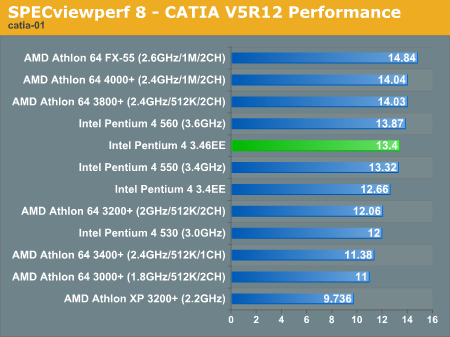
Lightscape Viewset (light-07)
"The light-07 viewset was created from traces of the graphics workload generated by the Lightscape Visualization System from Discreet Logic. Lightscape combines proprietary radiosity algorithms with a physically based lighting interface.
The most significant feature of Lightscape is its ability to accurately simulate global illumination effects by precalculating the diffuse energy distribution in an environment and storing the lighting distribution as part of the 3D model. The resulting lighting "mesh" can then be rapidly displayed."
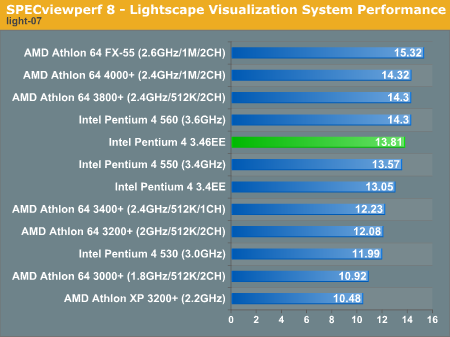
Maya Viewset (maya-01)
"The maya-01 viewset was created from traces of the graphics workload generated by the Maya V5 application from Alias.
The models used in the tests were contributed by artists at NVIDIA. Various modes in the Maya application are measured.
State changes as made by the application are included throughout the rendering of the model, including matrix, material, light and line-stipple changes. All state changes are derived from a trace of the running application. The state changes put considerably more stress on graphics subsystems than the simple geometry dumps found in older viewsets.
As in the Maya V5 application, array element is used to transfer data through the OpenGL API."

Pro/ENGINEER (proe-03)
"The proe-03 viewset was created from traces of the graphics workload generated by the Pro/ENGINEER 2001TM application from PTC.
Two models and three rendering modes are measured during the test. PTC contributed the models to SPEC for use in measurement of the Pro/ENGINEER application. The first of the models, the PTC World Car, represents a large-model workload composed of 3.9 to 5.9 million vertices. This model is measured in shaded, hidden-line removal, and wireframe modes. The wireframe workloads are measured both in normal and antialiased mode. The second model is a copier. It is a medium-sized model made up of 485,000 to 1.6 million vertices. Shaded and hidden-line-removal modes were measured for this model.
This viewset includes state changes as made by the application throughout the rendering of the model, including matrix, material, light and line-stipple changes. The PTC World Car shaded frames include more than 100MB of state and vertex information per frame. All state changes are derived from a trace of the running application. The state changes put considerably more stress on graphics subsystems than the simple geometry dumps found in older viewsets.
Mirroring the application, draw arrays are used for the shaded tests and immediate mode is used for the wireframe. The gradient background used by the Pro/E application is also included to better model the application workload."
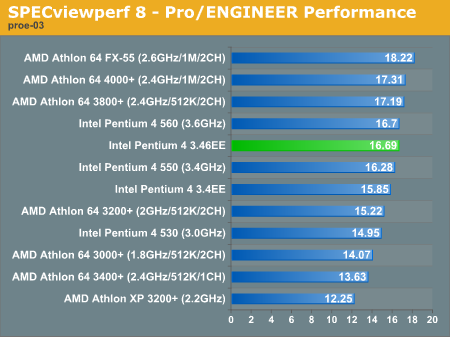
SolidWorks Viewset (sw-01)
"The sw-01 viewset was created from traces of the graphics workload generated by the Solidworks 2004 application from Dassault Systemes.
The model and workloads used were contributed by Solidworks as part of the SPECapc for SolidWorks 2004 benchmark.
State changes as made by the application are included throughout the rendering of the model, including matrix, material, light and line-stipple changes. All state changes are derived from a trace of the running application. The state changes put considerably more stress on graphics subsystems than the simple geometry dumps found in older viewsets.
Mirroring the application, draw arrays are used for some tests and immediate mode used for others."
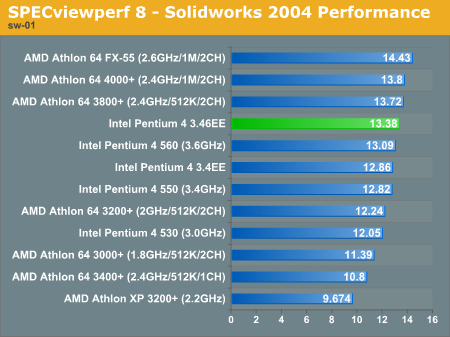
Unigraphics (ugs-04)
"The ugs-04 viewset was created from traces of the graphics workload generated by Unigraphics V17.
The engine model used was taken from the SPECapc for Unigraphics V17 application benchmark. Three rendering modes are measured -- shaded, shaded with transparency, and wireframe. The wireframe workloads are measured both in normal and anti-alised mode. All tests are repeated twice, rotating once in the center of the screen and then moving about the frame to measure clipping performance.
The viewset is based on a trace of the running application and includes all the state changes found during normal Unigraphics operation. As with the application, OpenGL display lists are used to transfer data to the graphics subsystem. Thousands of display lists of varying sizes go into generating each frame of the model.
To increase model size and complexity, SPECviewperf 8.0 replicates the model two times more than the previous ugs-03 test."











63 Comments
View All Comments
AlexWade - Sunday, October 31, 2004 - link
Now if only I can afford and find one ...MMORPGOD - Sunday, October 31, 2004 - link
IntelUser2000 - Sunday, October 31, 2004 - link
DDR2 is not a stupid move, its the speed they are at that's stupid. Remember DDR? They first ones ran at 200MHz, which were 50% faster than PC133 and still way faster than the enthusiast 166MHz SDRAMs. DDR's latency were higher, but since their clock is much higher, it wasn't a big problem as DDR2 vs DDR. However, PC1600 DDR still was not a big improvement over PC133, it was when PC2100 came that DDR started to shine.Another thing:
Quote:"With the original 925X chipset we were a bit unhappy to see that the Pentium 4's 800MHz FSB was paired with DDR2-533, creating one of those frustrating asynchronous situations."
I think 800MHz bus with DDR2-533 is actually VERY synchronous. First look it doesn't look like it. However since DDR2s latency is higher, it doesn't act like DDR533, it acts like DDR400. There was a Tomshardware review that was trying to predict the performance of 1066MHz bus.
First config was: 800MHz bus, DDR2-533
Second: 1066MHz bus, DDR2-533
Third: 1066MHz bus, DDR2-667
Guess which one had the biggest performance benefit? The third one, contrary to most people's belief. I think that tells that because of the DDR2's latency, you need DDR2-667 to perfectly match 1066MHz bus. Since Intel chose to stick with DDR2-533, they have created an asynchronous situation, making the performance not so much better. They should have went DDR2-667 with 1066MHz bus.
SLIM - Sunday, October 31, 2004 - link
One thing I didn't catch from anand's review is that the 3.46ee is rated at 110.7 watts according to [H]; just another reason to go AMD. Makes you wonder what the 3.73ee (which is supposed to launch this quarter) will have for a heatsink...Prometia for everyone:)
Tides - Sunday, October 31, 2004 - link
I remember reading a week or two ago about "AMD is going to have a tough time keeping up," from the lips of an Intel guy.Was this latest outing with the new P4EE's the proof? Perhaps I lack the foresight to understand what will happen in 6 months time, but in who's world is AMD going to have a hard time keeping up with? Cyrix's?
Tides - Sunday, October 31, 2004 - link
"ddr2 is a stupid move."Tides - Sunday, October 31, 2004 - link
not to mention, hi, ddr2 for is a stupid move. high latency, crap bandwidth, not just twice the price since you wouldn't have had to upgrade your ram otherwise if you already had solid ddr1.it reminds me of rambus. and beta max. and sony's discman. what else? ddr2 should have never come out imo. ddr3 is where it's at, hopefully amd will go straight to ddr3 and save it's customers and themselves the hastle of having to buy new ram, new mobos and so forth just to have to do it again with ddr3. i like faster everything as much as everyone else, but amd 64 proves ddr1 is alive and well, and ddr2 is what? exactly? perhaps in a year down the road, or two; it'll be worth something at the end of it's life cycle, just as ddr3 starts poking it's head about.
GhandiInstinct - Sunday, October 31, 2004 - link
Why don't they just screw any other core and focus on pumping out $1000 EEs? Everyones buying them, might as well. I really would like to know the stats for Intel's sales on their new cpus and chipsets, exact numbers.GhandiInstinct - Sunday, October 31, 2004 - link
#17 I was infering this world is off balance with that reality...Gnoad - Sunday, October 31, 2004 - link
wow. $1000 a pop for a CPU that gets destroyed by processors that cost a quarter as much. Totally asinine.